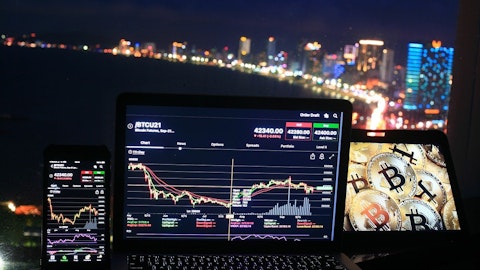Mark Newman: Yes. So, John, it’s a great question. And as I said in my opening remarks, we are seeing clear indications of this demand weakness decelerating. We typically think of a TT cycle as 12 months to 18 months. And clearly, you know, when we look at volume demand deterioration starting in late Q3 last year, you know, we’re at the 12-month market here. And as I said, we’re seeing real deceleration in the demand reduction. And in fact, I would say, as we look at our AP order book, we’re seeing indication there of regaining demand. Now, as we look out into next year, our expectation would be that demand gains are more gradual. But it feels to us like the destocking is over and obviously as we go into Q4, which is typically a weaker quarter for TT our expectation is that, you know, volumes will be flat to slightly down. I’ll ask Jonathan to comment on sort of more volume details here.
Jonathan Lock: Yes, Mark, thanks. Just building on your comments, you know, as you said, we are starting to see some green shoots here in AP, while demand, you know, around the rest of the world is fairly muted. But part of the transformation plan, part of the TT transformation plan that we started with the Kuan Yin shutdown was to control what we can control, right? So that plan is going to deliver $15 million of cost savings in the fourth quarter and $50 million to $100 million over the course of next year, right? So we plan on showing $100 million improvement in our TT earnings profile into 2024. And that’s really what the team is focused on driving for the remainder of the year and on into next year. So John, we’re really excited about the transformation in TT that’s underway and ensuring that we can be the most cost competitive, the lowest cost, and the best TiO2 producer in the world.
John McNulty: Got it. Okay, fair enough. And then maybe we can just shift on our second question just over to the TSS business and the data center opportunity that you highlighted in the prepared remarks. I mean, you’re talking about some pretty significant cuts in terms of how data centers can cut down their energy. I guess, can you help us in some way to frame the market potential for a product like this as you, kind of, ramp it up in late ‘25 and into ‘26 and ‘27?
Mark Newman: Yes. So first of all, the immersion cooling market represents a whole new ad to our TSS franchise, beyond the strong Opteon platform. So we’re hugely excited about the potential of almost another business on top of what we already have going into 2025. As we have looked at the addressable market, you know, I think there are estimates now running, you know, out through 2030 that suggest this is a $2 billion to $3 billion addressable market. But John, as you know, I mean, every day you hear another headline on AI, and all that is happening in quantum computing that is really driving a significant growth in data centers. You know, the energy reduction for a cooling servers, you know, is an estimated 90%. You know, it’s certainly high-80s based on the math I’ve seen.
So it’s a significant reduction in energy, and also a significant reduction, it essentially eliminates water usage for cooling data centers where today you’re cooling massive amounts of air. So both in terms of the climate impact and obviously the opportunity, it’s significant. We’re in the process right now of going through the product registration process. And as we’ve said earlier, we plan to start commercializing that product in 2025 and obviously would have a significant ramp from there as we look at the addressable market that I talked about by 2030.
John McNulty: Got it. Thanks very much for the call.
Operator: Your next question comes from a line of Josh Spector from UBS. Your line is open.


